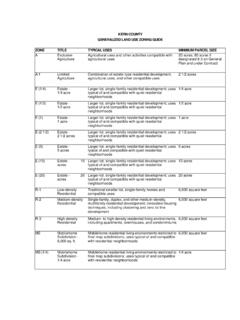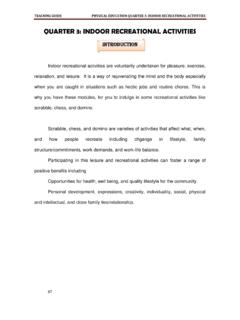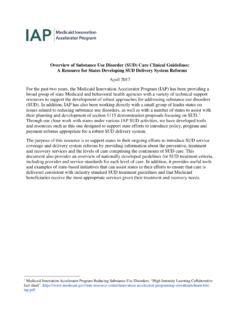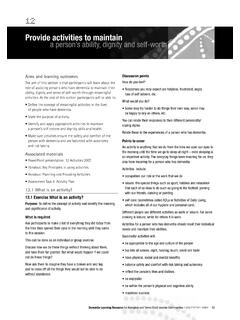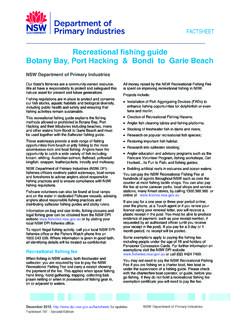Transcription of Mooring Buoy Guide - Coral Reef
1 Mooring BuoyPlanning GuidePoly RopeBuoyWeightEye BoltAcknowledgmentsThe Project AWARE Foundation and PADI International Resort Association (PIRA) have worked to develop thisbooklet on Mooring buoys to address some of the issues relating to the planning, installation and maintenanceof a Mooring buoy following pages are excerpts and/or complete documents from many sources and contributors. We wishto express gratittude to the leaders and experts in their fields, for their time and contributions to future mooringbuoy programs around the world, and to all who contributed in one way or special thanks goes out to Athline Clark, John and Judy Halas, Center for Marine Conservation, DavidMerrill and Jeff Fisher for their contributions to this document.
2 An additonal thanks goes out to Joy Zuehls,Jeanne Bryant, Dail Schroeder, Joe De La Torre, Greg Beatty and Kelsey of PADI Americas for their hard work onthe production, designs, illustrations and typography of this buoy Planning GuidePublished by International PADI, Tomas StreetRancho Santa Margarita, CA 92688-2125 PRODUCT NO. 19300 (Rev. 3/05) Version International PADI, Inc. 1996-2005 All right is estimated that 40 percent of the world s Coral reefs are likely to seriously degrade, perhaps even beyondrecovery, by the year 2015. Population increase in coastal areas adjacent to reefs, waste disposal, pollution,sedimentation, overfishing, Coral mining, tourism and curio collection all damage Coral reefs. These are seriousproblems with complex solutions.
3 Other problems, serious but smaller in scale, also face the reefs. Anchors, forexample, pose a threat that can easily be seen by recreational divers: they simply rip Coral reefs apart. Deter-mined individuals and organized local groups can help solve this and similar the early 1970s, pioneering members of the dive community, whose livelihoods depend on the qualityof the reefs in their area, have championed the installation and use of Mooring buoys to lessen the harmafuleffects of anchors on Coral reefs. Over the years the movement has gathered momentum and is now widelyaccepted as an effective solution to one aspect of Coral reef Mooring buoy concept is simple: install a Mooring buoy close to or over a site where boats traditionallyanchor.
4 Instead of anchoring, boat users tie off to the Mooring and this lessens damage. Mooring buoys can alsobe used as an ongoing aid to Coral reef conservation. They may be used to zone an area for a particular activityand help avoid conflicts between, for example, fishermen and divers. If an area is being overused, moorings caneasily be removed, placed elsewhere, and replaced at the original site when it has had adequate recovery Mooring buoys requires professional expertise at all phases of project planning and implementa-tion. Several factos must be considered and in many situations, the scope of the project will demand cooperativeeffort between relevant government agencies and interested parties. The anticipated use of the project sitedetermines the number, location and type of moorings deployed.
5 Funding for installation and ongoing mainte-nance, a crucial element of any Mooring buoy system, must be organized. Educational programs must beundertaken to ensure that private users understand what the buoys are for and adequate arrangements forenforcement of the project or site regulations need to be in the effort involved in a Mooring buoy planning and installation project, the benefits far outweighthe work involved. Mooring buoy projects are firmly fixed as a healthy element in the future of the world s coralreefs. This booklet can be used as a valuable tool when developing a Mooring buoy program. It outlines thecomponents that need to be considered when taking on such a hope that you will use this booklet asa guideline in initiating the process of Mooring of ContentsSection I:The Importance of Coral ReefsSection II:Types of Mooring buoy SystemsSection III:The Benefits of Mooring BuoysSection IV:Management and Liability ConsiderationsSection V:Case Studies of Mooring buoy ProgramsSection VI:Getting Started on a Mooring buoy Project of Your Own1-1 Section IThe Importance of Coral ReefsOverviewIn this section you will find an introduction to the threats facing theaquatic ecosystem, specifically the Coral reefs.
6 A brief summary of theimportance of the Coral reefs and the interactions between peopleand corals will also be covered in this at Risk, Coral reefs, human use and climate change, aprogramme of action, Oct. A worldwide threat of ecological collapse2. The living reef3. People and corals4. The threats and the causes1-2 Reef at RiskCoral reefs, human use andclimate worldwide threat of ecological collapseFor once, the popular mythology contains some reefs can be likened to tropical forests in certainimportant ways. Both reefs and jungles are biologi-cally diverse in comparison with other are an essential supplier of protein to subsis-tence communities; a valuable currency earner forlow-income countries through exploitation of theirresources and through tourism; a protector of land;and a naturalist s , the analogy is equally apt withrespect to the dark side of the picture; though we havebarely tapped Coral reefs for the knowledge to begained or the natural products of interest to society,reefs are coming under increasing threat, almostexclusively because of human the world Coral reefs have suffered adramatic decline in recent years.
7 About IO% mayalready have been degraded beyond recovery. An-other 30% are likely to decline seriously within thenext 20 years. It has been predicted that more thantwo-thirds of the world s Coral reefs may collapseecologically within the lifetime of our grandchildren,unless we implement effective management of theseresources as an urgent reefs identified as being at greatest risk are inSouth and Southeast Asia, East Africa, and theCaribbean. An IUCN survey during 1984-1989 foundthat people had significantly damaged or destroyedreefs in 93 reefs and biodiversityCoral forms range from compact brain corals found inareas of high wave energy, through heavy branchingand plate corals in deeper water, off the reef edge, tosmaller finely branched corals found behind the reefcrest and in the reefs are generally divided into four maintypes: atolls, barrier reefs, platform reefs and fringingreefs.
8 Atolls, where reefs form a ring around a lagoon,are mainly found in the Indian and Pacific the Pacific they are grouped into long island chainssuch as those of Micronesia and Central reefs are separated from the mainland by adeep channel or lagoon, in which are found platformreefs. Fringing reefs are directly attached to land orseparated only by a shallow an individual reef, the total count of fishspecies and smaller marine organisms may exceedseveral thousand, but the number of individual coralspecies is much lower. The Indo-Pacific has some 700 reef building coralspecies, many times more than the tropical Atlantic(with some 35). In general, reefs in the Indo-Pacificdiffer from those of the Atlantic by having many morecoral species, and by supporting much richer animalcommunities on their intertidal reef flats.
9 The centreof Coral diversity is the Southeast. Asia region of the Indo-Pacific, and over 400species of hard Coral are believed to occur in Philip-pine away from this region, Coral diversitydeclines. Nevertheless, over 200 Coral species arerecorded from the northern and central Red Sea,about 200 from Madagascar and Chagos. The eastcoast of the Malaysian peninsula has 174 identifiedspecies, southeast India about 117, the Gulf of Thai-land some 60, and the Persian Gulf The living reefCorals are colonial animals that produce a calciumcarbonate (aragonite) skeleton beneath their film ofliving tissue. Reef-building or hermatypic coralscontain within their tissues symbiotic algae, so thatthe colony actually functions as a plant-animalcombination.
10 A Coral reef is the physical structurecreated by the growth of the reef a Coral colony dies through storm damage,SEAREEF FRONTREEF CREST REEF FLATBEACHCOMPACT CORALSSMALL CORALSSEAGRASSHEAVY BRANCHING CORALSBRANCHING AND PLATE CORALSD epth in metres51015 Figure 11-3 Limits to abundanceThe living matter produced by the plants and algae ina Coral reef system, its gross primary productivity, isbetween 30 and 250 times as great as that of the openocean. While the productivity of tropical oceans isvery low (18-50 grammes of carbon per sq. metre in ayear), Coral reefs produce 1500-5000g. The reason forthe higher productivity of reefs is that corals and coralcommunities recycle nutrients such as nitrate andphosphate which are in limited supply in open-oceansurface it would be a mistake to assume that the highproductivity of a Coral reef provides an automaticsurplus of potential food.





